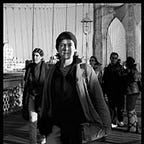Fall News Roundup (pt. 1)
Following the story over time: Childhood mental health on the Balkan Route. A Syrian family torn apart by resettlement. Military translators facing a difficult transition to life in the U.S. Plus, “Afghan Girl” — the saga continues.
The one year “anniversary” of Europe’s refugee summer & fall of 2015, in combination with the UN Summit for Refugees and Migrants in September, brought its share of photo stories. Among the follow-up reports on refugee families settling into new lives, three publications stood out for attempting to profile a specific angle or issue, rather than taking a purely chronological approach.
Ashley Gilbertson’s longterm commitment to the Raslan family began when he encountered the parents and three young children halfway on a journey that originated in Homs, Syria. Throughout, in both text and imagery, Gilbertson details the lengths the parents go through in order to spare their children the brunt of the fears, humiliations and desperation of first the Balkan route and later the life in limbo of Germany’s asylum bureaucracy. A sweet side note details the role that photography played in allowing the family to keep a sense of normalcy alive through it all. For an English version with full color photographs, see below:
Nicole Tung’s series of dual family portraits illustrates a New York Times story on Canada’s personal sponsorship approach to refugee resettlement. Tung’s photographs show two branches of the al-Hajj family, one brother living in a Bar Elias, Lebanon refugee camp, and the other in Toronto, Canada. Direct comparisons of living conditions and the educational opportunities afforded the children underscore the wrenching guilt and anguish experienced by a Syrian family who was able to escape the limbo of the camps, but remains technologically tethered to the relatives they had to leave behind.
Renée C. Byer of the Sacramento Bee worked as part of a team following up with a number of Afghan families and individuals who had been resettled in the northern California capital area as part of a special visa program for former interpreters and other service personnel working with coalition forces. Thus far, for many of them the experience has turned out to be a turbulent one, riven by struggles and disappointments.
Meanwhile, the Sharbat Gula saga continues… Known the world over as the green-eyed girl immortalized by Steve McCurry on the cover of National Geographic magazine in 1985, Gula came to represent Afghan refugees fleeing their country’s Soviet occupation, the expression in her eyes read by viewers as looking haunted, fierce and vulnerable at once – a look prompted, as narrated later by the photographer, by the anger and violation of being photographed, by a stranger, a man.
This, of course, was back in the day when images were printed on paper and photographers weren’t exchanging WhatsApp numbers with their subjects. The girl’s name, whereabouts or well-being remained unknown until a follow-up search and “reunion“ 17 years later revealed a woman aged by hardship and war. Published shortly after the American invasion, when presumably people would begin to return home, the moment seems to have warranted no more than a brief collective shrug of, “Sheesh, life seems to have been hard on her, eh?”
Fifteen years later, the war is still going, regional powers and allegiances are shifting, Afghanistan’s government is considered ineffectual and unable to protect its population, and Afghans have again been leaving the country in droves. Last month, Sharbat Gula was deported back to Afghanistan after being swept up in an investigation of ID fraud that is part of a larger clampdown on Afghan refugees residing in Pakistan.
There probably isn’t another face that will sum up the condition of “the refugee” in our collective conscience more aptly, and there probably isn’t a better-known contemporary example for the chasm between the photographed and the afterlife and exploitation of her image, and her complete lack of awareness and control over it. A close cousin would be Florence Owens Thompson, Dorothea Lange’s “Migrant Mother,” another less than happy study in iconic representation. Both sagas are complicated ones. They are the ones we hear about.
Sharbat Gula’s high profile deportation to a country of origin she doesn’t consider home, accompanied by her children who were born or grew up in Pakistan, is but one story among thousands of similar returns that are currently playing out. This would be a great moment for in-depth media coverage of the precarious situation of the 2.5 million longterm displaced Afghans residing in the country, and the mass exodus currently under way, now that the Pakistan‘s government is beginning to act on longstanding threats of evictions. Or so one would think.
Instead, there is media focus on Gula’s celebrity status, a photo op with president Ashraf Ghani, an apartment secured for her stay in Kabul, a foundation in her name, and medical treatment arranged in India for her Hepatitis C.
Meanwhile, here is Andrew Quilty with two stories on the thousands of non-famous Afghan returnees from Pakistan:
The @EverydayMigration Medium Publication will be a space for irregular news round-ups featuring publications of visual projects about migration, photographer interviews & behind the scenes, and award and exhibition news. Please send us ideas and links at: migration@everydayprojects.org
